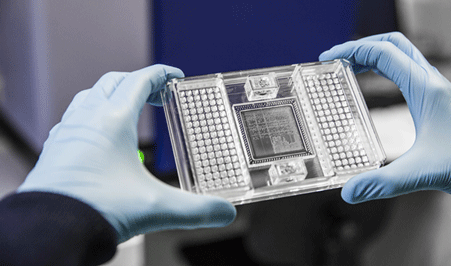Peptide Conjugation
Almac has extensive experience in the conjugation of peptides to a range of carrier proteins including keyhole limpet hemocyanin (KLH), Ovalbumin, Bovine Serum Albumin (BSA), and Human Serum Albumin (HSA).
Conjugation can be achieved using a wide variety of linkages, exploiting cysteine or lysine residues in the target peptide. The target peptide is manufactured to a high purity and excess peptide and linker are removed post-conjugation using size exclusion chromatography to produce a clean product. Characterization of the level of incorporation of the peptide on the surface of the carrier protein can be completed using high resolution mass spectrometry techniques.
Conjugation to Small Molecules
Working with fluorophores, chelating agents and therapeutics
We have proven expertise in the conjugation of peptides to a wide variety of small molecules, which can be designed and manufactured using a wide variety of linkages.
Our license with Life Technologies allows us access to conjugate synthetic peptides to a wide range of highly effective fluorophores, such as AlexaFluor®. Additionally, we have expertise in the synthesis of imaging agent precursors, such as DOTA and NOTA.
We have developed our own in-house technology to allow for the post-folding labeling of small proteins. This methodology, which utilizes a masked cysteine moiety, can be used to introduce a fluorophore or PEG molecule bearing maleimide functionality into the product after the disulfide bridges have been formed. This methodology has been applied to a number of chemokine, complement protein and conotoxin targets.

Peptide-Peptide Conjugation
Combining our extensive experience with unique technologies
Peptide-peptide conjugates can be designed and manufactured using a wide variety of linkages, including thiol-thiol, thioether, oximes and amine-thiol crosslinks. Each peptide component is manufactured to a high purity and the final conjugated product is purified by RP-HPLC to generate a clean, well-characterised product. The most recent addition to our peptide conjugation technology is the ability to site-specifically ubiquitylate peptides through an isopeptide linkage. This is completely unique to Almac and provides access to valuable tools in biological research.
Site-Specific Modification of Recombinant Proteins
Robust technology for total control over the conjugation process
We have developed a generic and robust technology for the site-specific attachment of small molecules, large polymers and peptides to various proteins. This methodology, which produces a targeted, site-specific ligation at the C-terminus, allows for total control over the conjugation process.
Our robust technology has many advantages: it’s high yielding and uses low ligand or label equivalents, the process is completed under aqueous conditions, it is compatible with disulfide bond containing proteins, it allows us to retain biological activity and, by using a single modification site, we can ensure a homogeneous product is produced. This technology is widely applicable to a range of labels and modifications and it has the potential to improve upon the native protein – for example, by modifying the protein to extend its half-life while maintaining biological activity.


